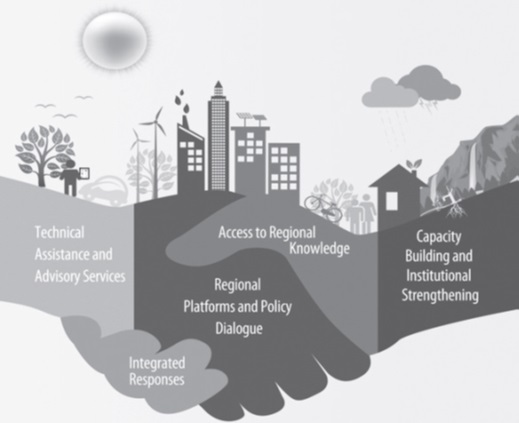
East Africa consists largely of plateaus and has most of the highest elevations in the continent. The two most striking highlands are in Ethiopia and Kenya, respectively, where large areas reach elevations of 6,500 to 10,000 feet (2,000 to 3,000 metres). Twin parallel rift valleys that are part of the East African Rift System run through the region. The Eastern, or Great, Rift Valley extends from the Red Sea’s junction with the Gulf of Aden southward across the highlands of Ethiopia and Kenya and continues on into Tanzania. The Western Rift Valley curves along the western borders of Uganda and Tanzania. Between the two rift valleys lies a plateau that comprises most of Uganda and western Tanzania and includes Lake Victoria. The volcanic massif of Kilimanjaro, the highest mountain in Africa, reaches 19,340 feet (5,895 metres) in northeastern Tanzania. The Horn of Africa, a major peninsular extension of the African mainland into the Arabian Sea, contains the vast lowland coastal plains of Somalia.
The climate of Eastern Africa is generally tropical, though average temperatures tend to be reduced by the region’s high elevations. Precipitation also is affected by varying elevation: Uganda, Tanzania, and western Kenya receive plentiful rainfall, while Somalia, eastern Ethiopia, and northeastern Kenya receive far less. The region’s vegetation ranges from woodlands and grasslands in the wetter regions to thorn bushes in semiarid areas. The grasslands of Tanzania and Kenya are renowned for their wildlife, in particular large migratory herds of ungulates. Eastern Africa is populated by 160 different ethnic groups or more, depending on the method of counting.
In a recent article Linda Ogallo has discussed policy issues that the region should adopt to secure food and endure climate change realities on the ground.
Vulnerability in Eastern Africa has been largely linked to poverty, with 40 per cent of the population in sub-Saharan Africa reportedly living below the poverty line, and thus lack the financial capacity to react and adapt to climate shocks. The region has also received frequent and recurring extreme climate events giving member states short recovery periods. For instance, in 2020 the region faced multiple unprecedented threats which were further compounded by the COVID-19 pandemic. As a result the World Bank projected a 3.3 per cent economic decline.
In order for local communities to effectively adapt to climate change, Eastern Africa needs an inclusive policy and legal framework that is operational at both the national and sub-national levels to effectively adapt and mitigate climate change. Member states in the Eastern African Community have a regional climate change policy, an example which IGAD member states should model. National Determined Contributions (NDCs) of the Paris Agreement are the primary instruments through which member states in Eastern Africa have committed to limit warming to between 1.5 to 2 degrees above pre-industrial levels. Most of the member states in the region were unable to meet the 2020 deadline to communicate or update their climate pledges. However, both Kenya and Ethiopia submitted their revised NDCs within the time frame, with Kenya increasing its emission reductions targets from 30per cent to 32per cent, while Ethiopia is committing to reduce economy-wide greenhouse gas emissions (GHG) by 220.59 MtCO2 eq by 2030. Some of the commitments made in the NDCs are contingent on availability of external financing.
While all member states in Eastern Africa submitted their first round of climate pledges, varying challenges exist in the implementation of the submitted NDCs. African Development Bank identified lack of appropriate legislation as a limitation in the implementation of NDCs for African countries [2]. Member states are lacking in or have outdated legal framework in key sectors to ensure successful achievement of the climate targets. Gaps further exists in the appropriate legal framework to fund proposed initiatives. Without the legal framework across sectors, implementation of national commitments becomes impossible even with increased access to financing.
Effective delivery of the climate change commitments by the region requires both institutional and technical capacity. Member states need to have the capacity to coordinate actors from government and non-government agencies and mobilize public participation. In addition, governments need to be able to integrate their priorities and policies in all relevant sectors. This consultative process requires a multi-sectoral technical team that is able to advocate the NDC priorities to all relevant actors, as well as increase buy-in from all stakeholders. Training and sensitization of all actors including consultative engagements is required to mainstream and streamline regulations with actions that enable counties to achieve their commitments. Countries also need the ability to collect data to monitor, re-evaluate and strengthen frameworks that have been put in place to achieve national commitments to the Paris Agreement.
The capacity limitation in Eastern Africa has been well documented, particularly in post-conflict countries, in fact all counties in Eastern Africa stated a need for institutional and technical capacity building to help track and report mitigation and adaptation priority actions [3] [4]. For most of the region, the institutional capacity gaps are in the areas of quantifying the gaps and needs; measuring and reporting of GHG emissions; and coordination and mainstreaming of existing policies.
While great strides have been made by the region in its commitments in response to the climate crisis, the connection between the commitments and implementation remains a critical gap. Sector-level policies required to meet the commitments are lacking. The technical capacity to develop multi-sectoral transformative policy frameworks is also inadequate.
The East African region continues to face multiple threats as a result of climatic impacts and the willingness to address the climate crisis is shared by both the society and political leaders. The opportunity therefore exists to enact laws and policies that increase the adaptive capacity of local communities, ensure sustainable development and implement a sustainable long-term climate strategy.
BY MENGISTEAB TESHOME
The Ethiopian Herald May 19/2021





